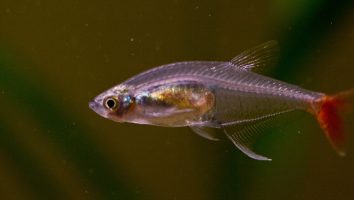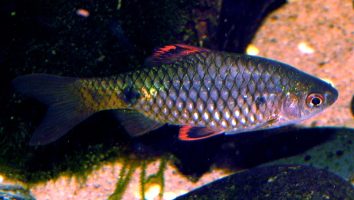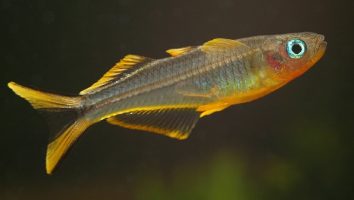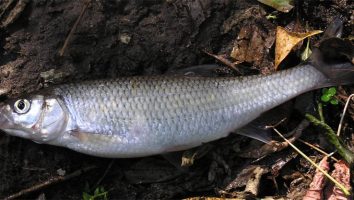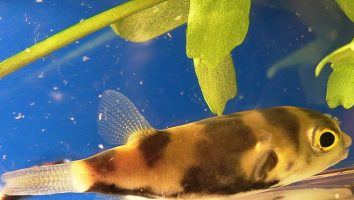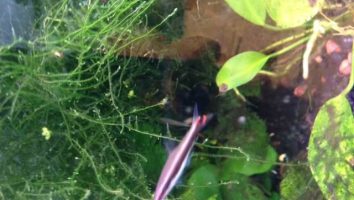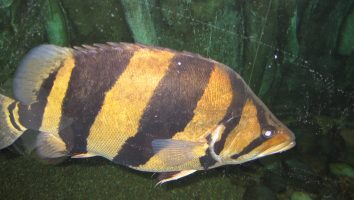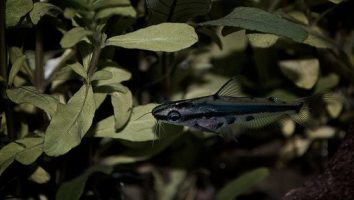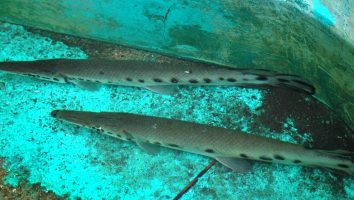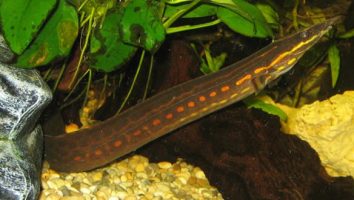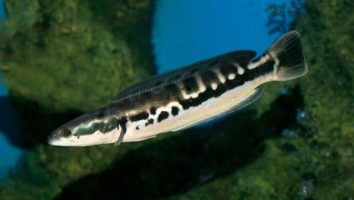The blood parrot cichlid is a beautiful and unique freshwater fish that is sure to turn heads. They have a bright red coloration that really stands out in a tank, and their personality is just as vibrant.
But before you run out and buy one of these fish, there are a few things you need to know. Blood parrot cichlids are not easy to care for, and they can be aggressive.
In this guide, we’ll teach you everything you need to know about blood parrot cichlid care. From their diet and tank mates, to their lifespan and size.
Table of contents
Species overview
The blood parrot cichlid (scientific name: Amphilophus citrinellus) is a hybrid species of cichlid that’s native to Central America.
They are a man-made species that was created by crossing the midas cichlid (Amphilophus citrinellus) with the redhead cichlid (Paraneetroplus synspilus).
This cichlid is known for its unique appearance, which is a result of its mixed lineage. It has a body shape that’s similar to that of a parrotfish, hence the name “blood parrot cichlid”.
This species is relatively popular in the aquarium trade, although they are not without their controversy. Many experts believe that blood parrot cichlids should not be bred due to the potential health complications that can arise from their mixed lineage.
Appearance
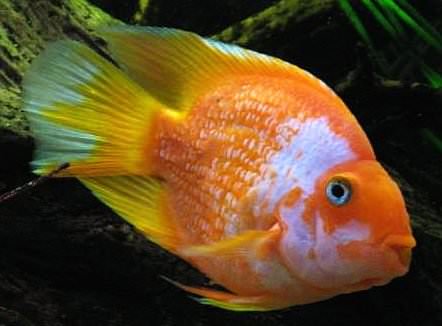
The first thing you’ll notice about the Blood Parrot Cichlid is their unique body shape. These fish are sort of triangular in shape and have a very flat face.
This flatness is actually caused by a genetic deformity that’s common in this species. While it doesn’t seem to bother them, it does give them a very unique look.
Their bodies are a beautiful orange color with blood-red spots all over. The fins on this fish are also red, but they’re a bit lighter in color.
The dorsal and anal fins are both triangular and about the same size. The caudal fin is forked and slightly taller than the dorsal and anal fins.
The ventral fins are very small and thin. Blood Parrot Cichlids also have a small adipose fin located between their dorsal and caudal fins.
Lifespan
The typical blood parrot cichlid lifespan is 10 to 15 years. That’s a pretty good run for a fish that only grows to be about six inches long!
Of course, as with any other animal, there are a number of factors that can impact a blood parrot cichlid’s lifespan.
Poor water quality, for instance, can shorten their life significantly. So can stress from things like bad tank mates or a lack of hiding places.
Generally speaking, though, these fish are pretty hardy and will do well in a wide range of conditions.
Size
Blood parrot cichlids grow to be about 6 to 8 inches in length. They are typically a bit smaller than other cichlid species.
Tank
Tank Size
The recommended tank size for blood parrot cichlids is 30 gallons. If you’re looking for a freshwater fish that can fit in an average-sized tank, this is not the fish for you.
If you want to keep two blood parrot cichlids in the same tank you’ll want to add at least another 30 gallons to that minimum number.
Another reason why you need to provide enough space is for the sake of enrichment and comfort. These fish like to roam and will often run gentle but steady laps around your tank. Giving them a little bit of extra space can go a long way in making sure they can comfortably turn around in the tank.
Water Parameters
Blood parrot cichlids are a bit more delicate than some of the other freshwater fish on this list. They’re not as forgiving when it comes to sudden changes in water parameters.
This is especially true when it comes to pH levels. Blood parrot cichlids prefer slightly alkaline water. A sudden drop in pH can result in stress and even death.
You should also be careful about water temperature. Blood parrots come from tropical climates and prefer warm water. They’re not as tolerant of temperature fluctuations as some of the other fish on this list.
Here are some basic water parameters to help create a healthy environment for your blood parrot cichlid.
- Water temperature: 72 to 82 degrees Fahrenheit
- pH levels: 7.0 to 8.0
- Water hardness: 5 to 15 dGH
- Alkalinity Levels: 4-12 dKH
What To Put In Their Tank
When it comes to setting up the inside of their tank, there are a few things you’ll need to take into consideration.
First and foremost, these fish are known to be escape artists. You’ll need to have a lid that fits snugly on top of the tank to prevent them from getting out.
In terms of the substrate, these fish don’t really have any specific requirements. You can use gravel, sand, or even a bare bottom tank if you want. Just avoid anything too sharp or jagged that could injure their belly.
As for decorations, it’s best to keep things on the simple side. A few pieces of driftwood or some large rocks should be plenty. Avoid anything small that they could potentially swallow.
Since they’re such active fish, they’ll appreciate some plants to help break up the line of sight in the tank. Hornwort, Water Wisteria, and Java Moss are all great choices.
Just be sure to avoid anything that has a strong current. They’re not the best swimmers so they could get swept away.
Common Diseases
One of the most common diseases that affects blood parrot cichlids is hole-in-the-head disease.
This disease is caused by a variety of factors, but the most common one is poor water quality. It’s also made worse by the presence of activated carbon in your filter.
This disease will present itself as one or two pits/holes in the skin of your blood parrot’s head. While it’s almost always curable, it will usually leave some scarring on your poor fish!
The other disease you’ll want to keep an eye out for is ich. This is obviously not a blood parrot-specific illness, but since ich is so common it’s definitely worth mentioning here.
This will show itself as white spots on the body, fish, and gills of your fish. We won’t do a full ich treatment guide here (there are plenty of those online) but it’s something you need to take very seriously if it affects your blood parrot.
Behavior & Temperament
The blood parrot cichlid is a unique fish that doesn’t have a lot of information available about its behavior and temperament. This is likely because it’s a man-made hybrid that’s not found in the wild.
With that being said, we do know that these fish are known to be relatively peaceful. They’re not as aggressive as other cichlid species, but they can still hold their own in a fight.
Blood parrot cichlids are also known to be curious creatures. They’re constantly exploring their environment and checking things out. This can sometimes get them into trouble, but it’s all part of their personality.
Overall, blood parrot cichlids are fun fish to have around. They’re not the most low-maintenance fish out there, but they’re certainly not the hardest to take care of either.
Tank Mates
The blood parrot cichlid is a man-made species. As a result, it doesn’t have any natural predators or tank mates.
This gives you a lot of flexibility when it comes to stocking your tank.
Because blood parrots are such a peaceful species, you can put them with almost any other fish. The only exception is putting them with other blood parrots.
These cichlids are known to fight with their own kind. If you want to keep more than one blood parrot, it’s best to have at least five. This will help reduce the risk of aggression and fighting.
Here are some compatible tank mates for blood parrots:
- Guppies
- Mollies
- Tetras
- Swordtails
- Platies
- Angelfish
- Discus
Breeding
The blood parrot cichlid is a man-made fish. It’s a hybrid of the midas and the redhead cichlid. As a result, it doesn’t have a ton of genetic diversity. That makes blood parrot cichlids pretty difficult to breed in captivity.
The first step is to find healthy, compatible breeding stock. That can be tricky since blood parrot cichlids don’t have a lot of genetic diversity. You might have to search high and low to find a good pair.
Once you have a pair, you need to set up a breeding tank. The tank should be at least 50 gallons. It should also have a sandy bottom and plenty of rocks and hiding places.
The water temperature should be between 78 and 82 degrees Fahrenheit. The pH should be between 7.0 and 8.0. The water hardness should be between 10 and 20 dGH.
When the tank is set up, add the pair of blood parrot cichlids. Give them a few weeks to acclimate to their new environment. Then, start feeding them a high-quality diet. Live foods are best, but frozen will work in a pinch.
After a few weeks, the female should be ready to spawn. She will lay her eggs on a flat surface like a rock or a piece of driftwood. The male will then fertilize them.
Once the eggs are laid, the parents will guard them diligently. They will also fan them with their fins to keep them clean and aerated.
The eggs will hatch in about a week. When they do, the parents will move them to a pit that they’ve dug in the sand. The fry will stay in the pit for another week or so before they start to venture out.
At this point, you can start feeding them baby brine shrimp or other small live foods. Once they’re big enough, you can move them to the main tank.
Conclusion
The Blood Parrot Cichlid is a great fish for beginner aquarists. They’re easy to care for and don’t require a lot of space, making them a great choice for those just starting out.
Blood Parrot Cichlids are also a great choice for experienced aquarists who want a low-maintenance fish.
While they’re not the most exciting fish in the world, they’re a great addition to any community tank and are sure to bring you years of enjoyment.

